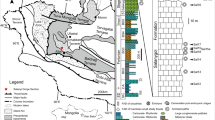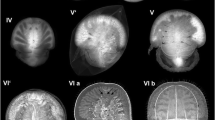Abstract
Based on more exquisitely preserved specimens of Markuelia hunanensis recently recovered from Middle and Upper Cambrian in western Hunan and in the light of Synchrotron radiation X-ray tomographic microscopy, the developmental sequence from cleavage through organogenesis to the pre-hatching of Cambrian embryo Markuelia, especially the developmental sequence during the pre-hatching stage, i.e. from the earliest period when the scalids and tail spines only took shape to the latest period (just about hatching), is established. This developmental sequence provides a pattern of embryonic development during the pre-hatching stage, which has not been established in the living scalidophorans (priapulids, loriciferans and kinorhynchs). Thus, it not only enriches our knowledge on the embryonic development of the extant descendants of Markuelia, but also opens a new window to the evolution and development of the animal.
Similar content being viewed by others
References
Yuan X L, Xiao S H, Yin L M, et al. Doushantuo Fossils: Life on the Eve of Animal Radiation. Hefei: University of Science and Technology of China Press, 2002. 1–171
Chen J Y. The Dawn of Animal World. Nanjing: Jiangsu Science and Technology Press, 2004. 1–366
Donoghue P C J, Dong X P. Embryos and ancestors, In: Briggs D E G, ed. Evolving Form and Function: Fossils and Development. New Haven: Yale Peabody Museum, 2005. 81–99
Xiao S, Zhang Y, Knoll A H. Three-dimensional preservation of algae and animal embryos in a Neoproterozoic phosphate. Nature, 1998, 391: 553–558
Xiao S, Knoll A H. Phosphatized animal embryos from the Neoproterozoic Doushantou formation at Weng’an, Guizhou, South China. J Paleont, 2000, 74: 767–788
Hagadorn J W, Xiao S, Donoghue P C J, et al. Cellular and Subcellular Structure of Neoproterozoic Animal Embryos. Science, 2006, 314: 291–294
Bengtson S, Yue Z. Fossilized metazoan embryos from the earliest Cambrian. Science, 1997, 277: 1645–1648
Yue Z, Bengtson S. Embryonic and post-embryonic development of the Early Cambrian cnidarian Olivoodies. Lethaia, 1999, 32: 181–195
Steiner M, Li G, Zhu M. Lower Cambrian small shelly fossils of northern Sichuan and southern Shaanxi (China), and their biostratigraphic significance. Geobios, 2004, 37: 259–275
Steiner M, Zhu M, Li G, et al. New early Cambrian bilaterian embryos and larvae from China. Geology, 2004, 32: 833–836
Kouchinsky A, Bengtson S, Gershwin L. Cnidarian-like embryos associated with the first shelly fossils in Siberia. Geology, 1999, 27: 609–612
Val’kov, A. K., Distribution of the oldest skeletal organisms and correlation of the lower boundary of the Cambrian in the southeastern part of the Siberian Platform. In: Khomentovsky V V, Yakshin M S, Karlova G A, eds. Late Precambrian and Early Paleozoic of Siberia, Vendian deposits. Novosibirsk: Institute of Geology and Geophysics, Siberian Branch of the Soviet Academy of the USSR, 1983. 37–48
Conway Morris S. Eggs and embryos from the Cambrian. BioEssays, 1998, 20: 676–682
Conway Morris S, Peel J S. Articulated halkieriids from the Lower Cambrian of North Greenland and their role in early protostome evolution. Phil Trans R Soc London Ser B, 1995, 347: 305–358
Donoghue P C J, Kouchinsky A, Waloszek D, et al. Fossilized embryos are widespread but the record is temporally and taxonomically biased. Evol Develop, 2006, 8: 232–238
Dong X P, Donoghue P C J, Cheng H, et al. Fossil embryos from the Middle and Late Cambrian period of Hunan, south China. Nature, 2004, 427: 237–240
Dong X P, Donoghue P C J, Cunningham J, et al. The anatomy, affinity and phylogenetic significance of Markuelia. Evol Develop, 2005, 7: 468–482
Donoghue P C J, Bengtson S, Dong X P, et al. Synchrotron X-ray tomographic microscopy of fossilised embryos. Nature, 2006, 442, 680–683
Zhang X G, Pratt B R. Middle Cambrian arthropod embryos with blastomeres. Science, 1994, 266: 637–639
Adrianov A V, Malakhov V V. Kinorhyncha: Structure, Development, Phylogeny and Taxonomy. Moscow: Nauka Publishing, 1994
Hammond R A. The burrowing of Priapulus caudatus. J Zool, 1970, 162: 469–480
Dong X P, Repetski J E, Bergstrom S M. Conodont biostratigraphy of the Middle Cambrian through Lowermost Ordovician in Hunan, South China. Acta Geol Sin, 2004, 78(6): 1185–1206
Budd G E. Lost children of the Cambrian. Nature, 2004, 427: 205–207
Brusca R C, Brusca G J. Invertebrates, Sunderland. Massachusetts: Sinauer Associates Inc, 2003. 1–936
Chen J Y, Oliveri P, Li Ch-W, et al. Precambrian animal diversity: putative phosphatised embryos from the Doushantuo formation of China. Nat Acad Sci Proc, 2000, 97: 4457–4462
Chen J Y, Oliveri P, Gao F, et al. Precambrian animal life: probable developmental and adult cnidarian forms from Southwest China. Develop Biol, 002, 248: 182–196
Chen J Y, Chi H M. Precambrian phosphatized embryos and larvae from the Doushantuo Formation and their affinities, Guizhou (SW China). Chin Sci Bull, 2005, 50(19): 2193–2200
Xiao S, Yuan X, Knoll A H. Eumetazoan fossils in terminal Proterozoic phosphorites? Nat Aca Sci Proc, 2000, 97: 13684–13689
Bengtson S. Tracing metazoan roots in the fossil record. In: Legakis A, Sfenthourakis S, Polymeni R, et al. eds. The New Panorama of Animal Evolution. Moscow: Pensoft, 2003. 289–300
Hua H, Chen Z, Zhang L Y. Early Cambrian phosphatized blastula-and gastrula-stage animal fossils from southern Shaanxi. Chin Sci Bull, 2004, 49(5): 487–490
Liu Y H, Li Y, Shao T Q, et al. Preliminary note on the phosphatized Punctatus with mouthparts and its embryos from Lower Cambrian in Niqiang, South Shaanxi, China. Acta Palaeontol Sin, 2006, 45(2): 182–194
Author information
Authors and Affiliations
Additional information
Supported by the National Natural Science Foundation of China (Grant Nos. 40572003 and 40372001), the Research Fund for Doctoral Program of High Education (Grant Nos. 20060001059 and 2000000127) and Laboratory of Paleobiology and Stratigraphy, Nanjing Institute of Geology and Palaeontology, Chinese Academy of Sciences (Grant No. 023106)
About this article
Cite this article
Dong, X. Developmental sequence of Cambrian embryo Markuelia . CHINESE SCI BULL 52, 929–935 (2007). https://doi.org/10.1007/s11434-007-0137-9
Received:
Accepted:
Issue Date:
DOI: https://doi.org/10.1007/s11434-007-0137-9




